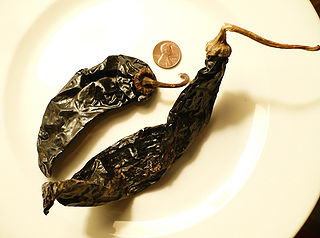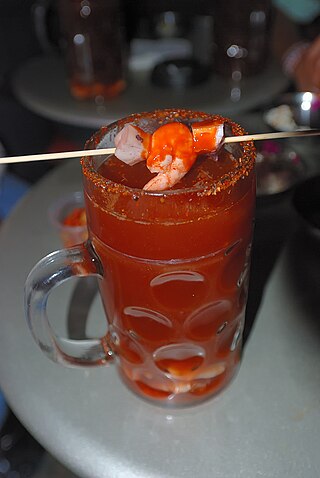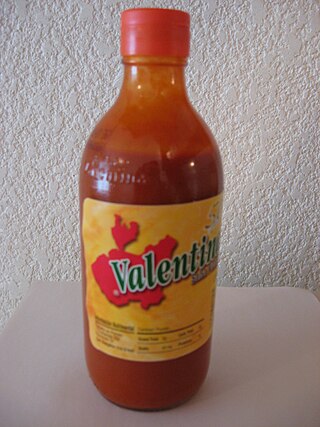
Mexican cuisine consists of the cooking cuisines and traditions of the modern country of Mexico. Its earliest roots lie in Mesoamerican cuisine. Mexican cuisine ingredients and methods begin with the first agricultural communities such as the Olmec and Maya who domesticated maize, created the standard process of nixtamalization, and established their foodways. Successive waves of other Mesoamerican groups brought with them their cooking methods. These included: the Teotihuacanos, Toltec, Huastec, Zapotec, Mixtec, Otomi, Purépecha, Totonac, Mazatec, Mazahua, and Nahua. With the Mexica formation of the multi-ethnic Triple Alliance, culinary foodways became infused.

Tomato sauce can refer to many different sauces made primarily from tomatoes, usually to be served as part of a dish, rather than as a condiment. Tomato sauces are common for meat and vegetables, but they are perhaps best known as bases for sauces for Mexican salsas and Italian pasta dishes. Tomatoes have a rich flavor, high water content, soft flesh which breaks down easily, and the right composition to thicken into a sauce when stewed, without the need for thickeners such as roux or masa. All of these qualities make them ideal for simple and appealing sauces.

An enchilada is a Mexican dish consisting of a corn tortilla rolled around a filling and covered with a savory sauce. Enchiladas can be filled with various ingredients, including meats, cheese, beans, potatoes, vegetables, or combinations. Enchilada sauces include chili-based sauces, such as salsa roja, various moles, tomatillo-based sauces, such as salsa verde, or cheese-based sauces, such as chile con queso.

Chili peppers, also spelled chile or chilli, are varieties of the berry-fruit of plants from the genus Capsicum, which are members of the nightshade family Solanaceae, cultivated for their pungency. Chili peppers are widely used in many cuisines as a spice to add "heat" to dishes. Capsaicin and related compounds known as capsaicinoids are the substances that give chili peppers their intensity when ingested or applied topically. Chili peppers exhibit a range of heat and flavors. This diversity is the reason behind the availability of different types of paprika and chili powder, each offering its own taste and heat level.

Salsa encompasses a variety of sauces used as condiments for tacos and other Mexican and Mexican-American foods, and as dips for tortilla chips. They may be raw or cooked, and are generally served at room temperature.

A chipotle, or chilpotle, is a smoke-dried ripe jalapeño chili pepper used for seasoning. It is a chili used primarily in Mexican and Mexican-inspired cuisines, such as Tex-Mex and Southwestern United States dishes. It comes in different forms, such as chipotles en adobo.

Hot sauce is a type of condiment, seasoning, or salsa made from chili peppers and other ingredients. Many commercial varieties of mass-produced hot sauce exist.

The pasilla chile or chile negro is the dried form of the chilaca chili pepper, a long and narrow member of the species Capsicum annuum. Named for its dark, wrinkled skin, it is a mild to hot, rich-flavored chile. As dried, it is generally 6 to 8 inches long and 1 to 1+1⁄2 inches in diameter.

The poblano is a mild chili pepper originating in Puebla, Mexico. Dried, it is called ancho or chile ancho, from the Spanish word ancho (wide). Stuffed fresh and roasted, it is popular in chiles rellenos poblanos.

A michelada is a Mexican drink made with beer, lime juice, assorted sauces, spices, and chili peppers. It is served in a chilled, salt-rimmed glass. There are numerous variations of this beverage throughout Mexico.

Valentina is a hot sauce brand manufactured by Salsa Tamazula, a company based in Guadalajara, Mexico. Like the parent company's Tamazula hot sauce, Valentina is made with puya chilis from Jalisco state, similar to the Guajillo chili and known by the name guajillo puya.

A guajillo chili or guajillo chile or chile guaco or mirasol chile is a landrace variety of the species Capsicum annuum with a mirasol chile fruit type. Mirasol is used to refer to the fresh pepper, and the term guajillo is used for the dry form, which is the second-most common dried chili in Mexican cuisine. The Mexican state of Zacatecas is one of the main producers of guajillo chilies. There are two main varieties that are distinguished by their size and heat factors. The guajillo puya is the smaller and hotter of the two. In contrast, the longer and wider guajillo has a more pronounced, richer flavor and is somewhat less spicy. With a rating of 2,500 to 5,000 on the Scoville scale, its heat is considered mild to medium.

San Pedro Atocpan is one of the communities that make up the borough of Milpa Alta in Mexico City. This location is known for the preparation of mole sauce, which employs over 90% of the community and provides almost all of the sauce that is eaten in Mexico City. Despite being in the Federal District and the second largest district in size, Milpa Alta is distinctly rural. Only 116,000 of Mexico City's 8 million inhabitants live in the entire borough, and as of 2005, only 8,997 lived in San Pedro Atocpan. The name "Atocpan" is from Nahuatl and means "on fertile soil" The community is located in the northwest of the borough, on the highway between Mexico City and Oaxtepec, Morelos. It has a territory of 87.65 hectares, and is about 2,500 meters above sea level. The land here is rugged as it is wedged between the Cuauhtzin Volcano and Teutli Mountain.

Mole, meaning 'sauce', is a traditional sauce and marinade originally used in Mexican cuisine. In contemporary Mexico the term is used for a number of sauces, some quite dissimilar, including mole amarillo or amarillito, mole chichilo, mole colorado or coloradito, mole manchamantel or manchamanteles, mole negro, mole rojo, mole verde, mole poblano, mole almendrado, mole michoacano, mole prieto, mole ranchero, mole tamaulipeco, mole xiqueno, pipián, mole rosa, mole blanco, mole estofado, tezmole, clemole, mole de olla, chimole, guacamole and huaxmole.

Oaxacan cuisine is a regional cuisine of Mexico, centered on the city of Oaxaca, the capital of the eponymous state located in southern Mexico. Oaxaca is one of the country's major gastronomic, historical, and gastro-historical centers whose cuisine is known internationally. Like the rest of Mexican cuisine, Oaxacan food is based on staples such as corn, beans, and chile peppers, but there is a great variety of other ingredients and food preparations due to the influence of the state's varied geography and indigenous cultures. Corn and many beans were first cultivated in Oaxaca. Well-known features of the cuisine include ingredients such as chocolate, Oaxaca cheese, mezcal, and grasshoppers (chapulines), with dishes such as tlayudas, Oaxacan-style tamales, and seven notable varieties of mole sauce. The cuisine has been praised and promoted by food experts such as Diana Kennedy and Rick Bayless and is part of the state's appeal for tourists.

The cuisine of Veracruz is the regional cooking of Veracruz, a Mexican state along the Gulf of Mexico. Its cooking is characterized by three main influences—indigenous, Spanish, and Afro-Cuban—per its history, which included the arrival of the Spanish and of enslaved people from Africa and the Caribbean. These influences have contributed many ingredients to the cooking including native vanilla, corn and seafood, along with rice, spices and tubers. How much the three mix depending on the area of the state, with some areas more heavily favoring one or another. The state has worked to promote its cuisine both in Mexico and abroad as part of its tourism industry.

Salsa verde is a type of spicy, green sauce in Mexican cuisine based on tomatillo and green chili peppers.

Bird's eye chili or Thai chili is a chili pepper variety from the species Capsicum annuum that is native to Mexico. Cultivated across Southeast Asia, it is used extensively in many Asian cuisines. It may be mistaken for a similar-looking chili derived from the species Capsicum frutescens, the cultivar siling labuyo. Capsicum frutescens fruits are generally smaller and characteristically point upwards. In the Marianas and Guam these are often called boonie peppers or Doni Sali, which can be term for regional wild varieties. The variation between different varieties can be significant for regional dishes or visuals, such as the Thai ornamental varieties.






























